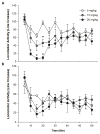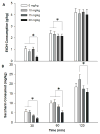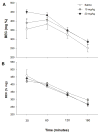α6β2 nicotinic acetylcholine receptors influence locomotor activity and ethanol consumption
- PMID: 28457669
- PMCID: PMC5466835
- DOI: 10.1016/j.alcohol.2017.02.178
α6β2 nicotinic acetylcholine receptors influence locomotor activity and ethanol consumption
Abstract
Nicotinic acetylcholine receptors (nAChRs) in the mesolimbic dopamine system have been implicated in ethanol behaviors. In particular, work in genetically engineered mice has demonstrated that α6-containing nAChRs are involved in ethanol consumption and sedation. A limitation of these studies is that the alteration in the receptor was present throughout development. The recently described α6β2 antagonist, N,N-decane-1,10-diyl-bis-3-picolinium diiodide (bPiDI), now makes it possible to test for the involvement of these receptors using a pharmacological approach. The aim of this study was to examine the role of α6β2 nAChRs in ethanol behaviors using a pharmacological approach. Adolescent C57BL/6J mice were treated with bPiDI 30 min prior to testing the mice for binge-like ethanol consumption in the drinking-in-the-dark (DID) test, ethanol-induced motor incoordination using the balance beam, and ethanol-induced sedation using the Loss of Righting Reflex (LORR) paradigm. Adolescent animals were chosen because they express a high amount of α6 mRNA relative to adult animals. Control studies were also performed to determine the effect of bPiDI on locomotor activity and ethanol metabolism. Female mice treated with 20 mg/kg bPiDI had reduced locomotor activity compared to saline-treated animals during the first 30 min following an acute injection. Pretreatment with the α6β2 antagonist reduced adolescent ethanol consumption but also reduced saccharin consumption. No significant effects were observed on ethanol-induced ataxia, sedation, or metabolism. This study provides evidence that α6β2 nAChRs are involved in locomotor activity as well as ethanol and saccharin consumption in adolescent animals.
Keywords: Ataxia; CHRNA6; Consumption; Ethanol; Nicotinic acetylcholine receptors; Sedation.
Copyright © 2017 Elsevier Inc. All rights reserved.
Figures





Similar articles
-
The Nicotinic α6-Subunit Selective Antagonist bPiDI Reduces Alcohol Self-Administration in Alcohol-Preferring Rats.Neurochem Res. 2016 Dec;41(12):3206-3214. doi: 10.1007/s11064-016-2045-3. Epub 2016 Aug 29. Neurochem Res. 2016. PMID: 27573375
-
The α3β4 nicotinic acetylcholine receptor antagonist 18-Methoxycoronaridine decreases binge-like ethanol consumption in adult C57BL/6J mice.Alcohol. 2019 Sep;79:1-6. doi: 10.1016/j.alcohol.2018.11.006. Epub 2018 Nov 26. Alcohol. 2019. PMID: 30496781
-
bPiDI: a novel selective α6β2* nicotinic receptor antagonist and preclinical candidate treatment for nicotine abuse.Br J Pharmacol. 2011 May;163(2):346-57. doi: 10.1111/j.1476-5381.2011.01220.x. Br J Pharmacol. 2011. PMID: 21232049 Free PMC article.
-
Nicotinic mechanisms involved in the dopamine activating and reinforcing properties of ethanol.Behav Brain Res. 2000 Aug;113(1-2):85-96. doi: 10.1016/s0166-4328(00)00203-5. Behav Brain Res. 2000. PMID: 10942035 Review.
-
The neurobiology of binge-like ethanol drinking: evidence from rodent models.Physiol Behav. 2012 Jun 6;106(3):325-31. doi: 10.1016/j.physbeh.2011.12.026. Epub 2012 Jan 8. Physiol Behav. 2012. PMID: 22245775 Free PMC article. Review.
Cited by
-
Cholinergic System and Its Therapeutic Importance in Inflammation and Autoimmunity.Front Immunol. 2021 Apr 15;12:660342. doi: 10.3389/fimmu.2021.660342. eCollection 2021. Front Immunol. 2021. PMID: 33936095 Free PMC article. Review.
-
α-Conotoxin TxIB Inhibits Development of Morphine-Induced Conditioned Place Preference in Mice via Blocking α6β2* Nicotinic Acetylcholine Receptors.Front Pharmacol. 2021 Dec 3;12:772990. doi: 10.3389/fphar.2021.772990. eCollection 2021. Front Pharmacol. 2021. PMID: 34925031 Free PMC article.
-
The role of nicotinic acetylcholine receptors in alcohol-related behaviors.Brain Res Bull. 2020 Oct;163:135-142. doi: 10.1016/j.brainresbull.2020.07.017. Epub 2020 Jul 22. Brain Res Bull. 2020. PMID: 32707263 Free PMC article. Review.
-
α-Conotoxin TxIB Improved Behavioral Abnormality and Changed Gene Expression in Zebrafish (Danio rerio) Induced by Alcohol Withdrawal.Front Pharmacol. 2022 Feb 1;13:802917. doi: 10.3389/fphar.2022.802917. eCollection 2022. Front Pharmacol. 2022. PMID: 35177988 Free PMC article.
-
Bidirectional sex-dependent regulation of α6 and β3 nicotinic acetylcholine receptors by protein kinase Cε.Addict Biol. 2021 May;26(3):e12954. doi: 10.1111/adb.12954. Epub 2020 Aug 10. Addict Biol. 2021. PMID: 32776643 Free PMC article.
References
-
- Azam L, Chen Y, Leslie FM. Developmental regulation of nicotinic acetylcholine receptors within midbrain dopamine neurons. Neuroscience. 2007;144(4):1347–1360. https://doi.org/10.1016/j.neuroscience.2006.11.011. - DOI - PMC - PubMed
-
- Bowers BJ, McClure-Begley TD, Keller JJ, Paylor R, Collins AC, Wehner JM. Deletion of the alpha7 nicotinic receptor subunit gene results in increased sensitivity to several behavioral effects produced by alcohol. Alcoholism, Clinical and Experimental Research. 2005;29(3):295–302. - PubMed
-
- Champtiaux N, Han ZY, Bessis A, Rossi FM, Zoli M, Marubio L, … Changeux J-P. Distribution and pharmacology of alpha 6-containing nicotinic acetylcholine receptors analyzed with mutant mice. The Journal of Neuroscience: The Official Journal of the Society for Neuroscience. 2002;22(4):1208–1217. - PMC - PubMed
-
- Cohen BN, Mackey EDW, Grady SR, McKinney S, Patzlaff NE, Wageman CR, … Drenan RM. Nicotinic cholinergic mechanisms causing elevated dopamine release and abnormal locomotor behavior. Neuroscience. 2012;200:31–41. https://doi.org/10.1016/j.neuroscience.2011.10.047. - DOI - PMC - PubMed
-
- Crabbe JC, Metten P, Ponomarev I, Prescott CA, Wahlsten D. Effects of genetic and procedural variation on measurement of alcohol sensitivity in mouse inbred strains. Behavior Genetics. 2006;36(4):536–552. https://doi.org/10.1007/s10519-006-9067-6. - DOI - PubMed
Publication types
MeSH terms
Substances
Grants and funding
LinkOut - more resources
Full Text Sources
Other Literature Sources
Medical
Miscellaneous

